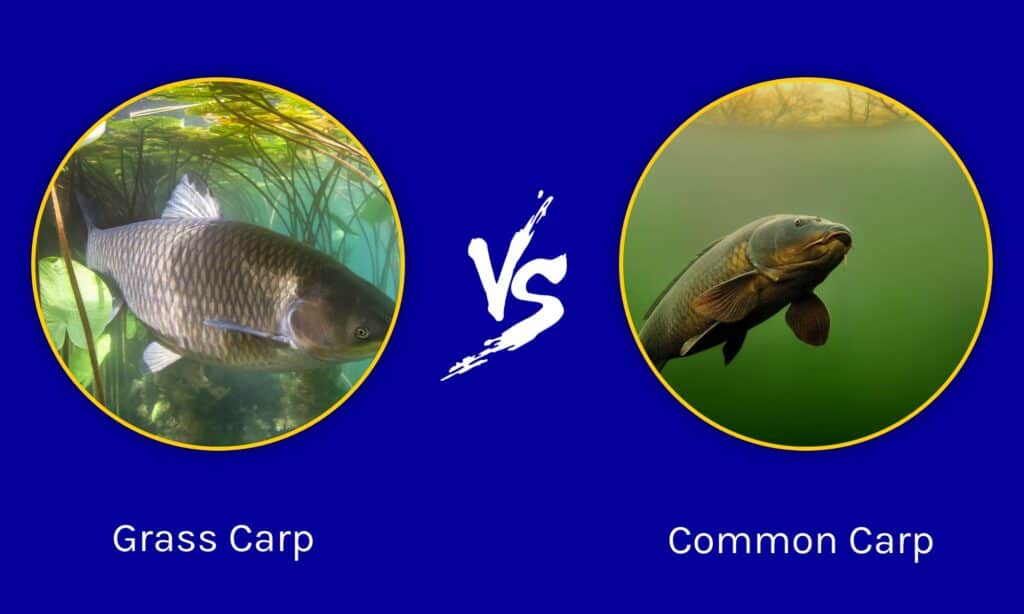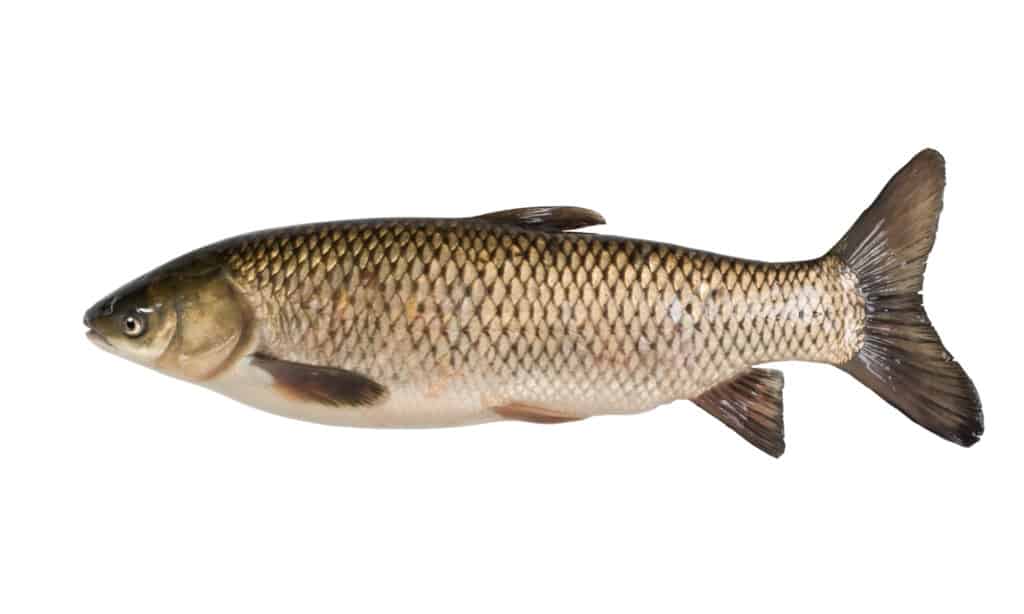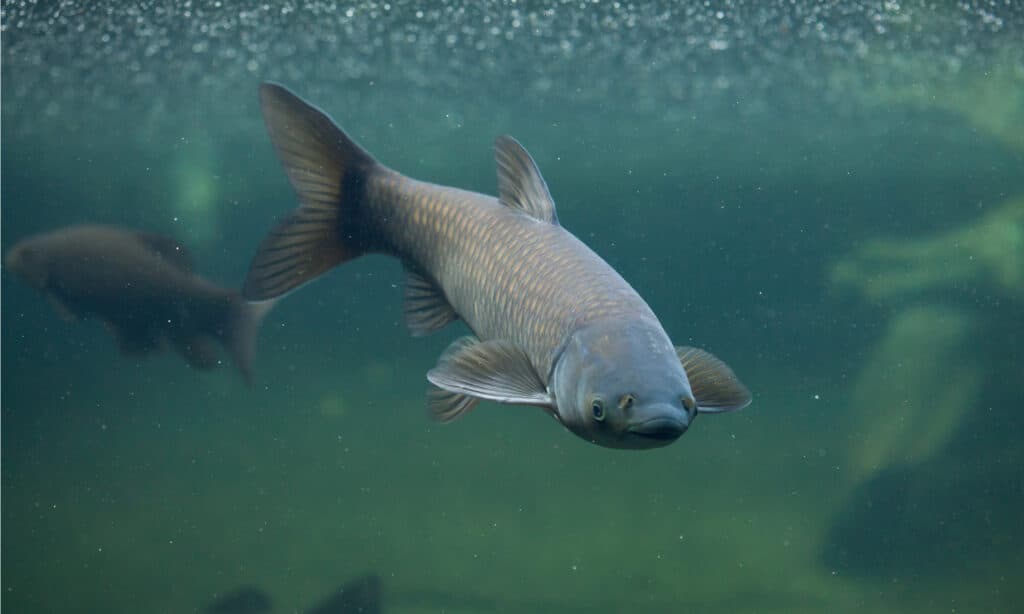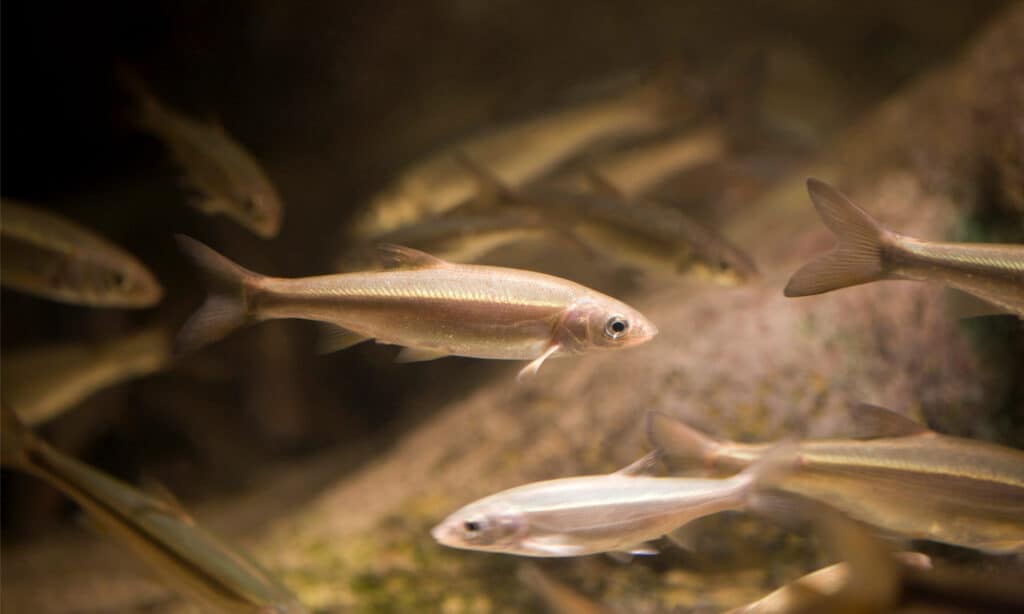Long hot summers help carp grow to be quite large.
However, no matter how perfect the summer is, the common carp usually maxes out at a smaller size than the grass carp. Grass carp are famous for reaching sizes of 80 pounds or more.
How can these fish carry a similar name but grow up so differently? With this fish comparison guide, we’ll help you answer this questions and more. Read on to learn all about grass carp vs common carp.
Key Differences: Grass Carp vs Common Carp

| Grass Carp | Common Carp | |
|---|---|---|
| Classification | Family Cyprinidae Scientific name: Ctenopharyngodon idella | Family Cyprinidae Scientific name: Cyprinus carpio |
| Physical Description | Dark olive color Pigmentation outlining scales Oblong body shape Centered eyes Flattened head Can be 5 ft long Can weigh 80 lb | Barbells (whisker) at corners of mouth Long dorsal spine Less pronounced scales Olive-green and silver colors Red-orange fins |
| Preferred Habitat | Originally from rivers and lakes throughout Eastern Asia Large rivers and lakes Large slow moving body of water | Abundant in the Great Lakes Large rivers and lakes with mild temperatures |
| Diet | Omnivore Primarily herbavorious | Omnivore Primarily herbavorious |
| Ecological Impact | Degrading water quality Threatening native species Considered an invasive species | Unclear ecological impacts Not considered invasive |
Comparing Grass Carp vs Common Carp
The key difference between grass carp vs common carp is their anatomy. Grass carps tend to be oblong and can reach five feet in length. In addition, the classification, physical description, preferred habitat, diet, and ecological impact of both fish differ.
Both fish belong to the same family, Cyprinidae, but that’s about the only similarity they share. The scientific name from common carp is Cyprinus carpio, and the scientific name for grass carp is Ctenopharyngodon idella.
Common carp have whisker-like appendages at the corner of their mouth called barbells. Catfish have similar barbells, but they’re not identical. However, none of the invasive Asian carp species, such as grass carp, have barbells.
Both fish are omnivores, but grass carp eat many more small fish. Common carp prefer to stick to a vegetarian diet when they can.
Ecologically, grass carp are negatively impacting the environment. The relationship between common carp and the environment is a bit more complex. Keep reading to dive deeper into the differences between grass carp vs common carp.
Grass Carp vs Common Carp: Classification

Grass carp are an invasive species.
©Oleg_Z/Shutterstock.com
The four Asian carp species include silver, big head, black, and grass carp. The grass carp’s scientific name is Ctenopharyngodon idella. They’re a species of fish that belong to the family Cyprinidae.
Even though common carp belong to the same family, they have a different genus. That’s why the scientific name for common carp is Cyprinus carpio.
Common carp aren’t native to North America, but they also don’t have the title of being an invasive species. This is because common carp were introduced long ago and are now widely distributed throughout North and Eastern America.
Grass Carp vs Common Carp: Physical Description

Grass carp have an oblong body shape and flattened head.
©Vladimir Wrangel/Shutterstock.com
Grass carp have scales on their back and sides. A special pigmentation outlines the scales giving the fish a unique cross-hatch effect.
You’ll find that grass carp have an oblong body shape and a flattened head. Unlike other invasive Asian carp species, grass carp have centered eyes. Their colors can be olive-brown to brassy and silvery-white. Some grass carp even have black color pigmentation.
Grass carp continue growing, even after they fully mature. Once they reach maximum size, a grass carp can weigh as much as 80 lb or more (the world record hit 87 pounds 10 ounces). They can grow to be 5 ft in length. The longer they grow, the easier it is for them to escape hungry predators. For a grass carp to escape being eaten by a largemouth bass, it has to be 17.7 inches long.
Look at their mouth when you’re trying to tell apart a common carp and a grass carp. The common carp will have what appears to be whiskers right near the corners of its mouth.
These whisker-like appendages are barbells. None of the invasive Asian carp species, such as grass carp, have barbells.
Common carp have a long dorsal fin that’s called a dorsal spine. At the same time, grass carp have a short dorsal fin. There’s also a difference in their coloration.
Common carp don’t have the same netted pattern that grass carp display. Instead, their scales are less pronounced.
You’ll find common carp have a variety of colors ranging from silver to olive-green. Their back and sides are usually gray or brass. Their bellies are yellowish, and they have red-orange fins.
Grass Carp vs Common Carp: Preferred Habitat
Grass carps come from large rivers and lakes throughout Eastern Asia. They’re also native to Russia through Northern Vietnam. Now, grass carp are plentiful throughout North America.
A grass carp’s favorite spot to hang out is a large, slow-moving body of water. When it’s time to spawn, they’ll make their way to larger rivers with stronger currents.
Egg survival depends on the water’s temperature. Grass carp eggs can only tolerate temperatures around 64° Fahrenheit. However, once the grass carp grow up, they’re happy to hang out and water as cold as 32° Fahrenheit.
Common carp used to live in Asia, but they were introduced to Canada from non-native populations throughout Europe. Now, you can find common carp inhabiting the upper St Lawrence River, Lake Superior, and many other inland rivers and lakes.
Common carp prefer hanging out in the Great Lakes because everything they need is there. The temperatures, water flow, and food sources in the Great Lakes are perfect for common carp to thrive.
Grass Carp vs Common Carp: Diet

Grass carp are omnivores, eating a diet of small fish, plants, and insects.
©iStock.com/y-studio
Grass carp are omnivores, but they mainly have an herbivorous diet. These fish love feeding on aquatic plants, small fish, insects, and other invertebrates. They can consume up to 40% of their body weight every day.
Common carp are omnivores, but they prefer a vegetarian diet. They’re happy to feed on aquatic vegetation in murky or clear water. Along with aquatic vegetation, they’re also known to eat insects, fish eggs, and planktonic crustaceans.
Grass Carp vs Common Carp: Ecological Impact
Unfortunately, grass carp are an invasive species, making it difficult for native fish to thrive. By reducing food sources, spawning areas, and shelter, grass carp pose a significant threat to the natural ecosystem.
Since the grass carp can only digest half of the food they eat, they wind up expelling a lot of waste into the water. The excess nutrients make it more likely that algae blooms will pollute the water and negatively impact light levels.
Alternatively, common carp have a complex relation to the environment. Even though they’re technically not native, they’re not considered an invasive species.
Some researchers feel that common carp populations are dominating lake and wetland ecosystems. The fish uproot aquatic macrophytes when they feed and spawn. Their activities could also limit light penetration which bodies of water need for macrophyte growth. More studies will need to be conducted to fully understand the impact of common carp in our waterways fully.
The photo featured at the top of this post is ©
Thank you for reading! Have some feedback for us? Contact the AZ Animals editorial team.






